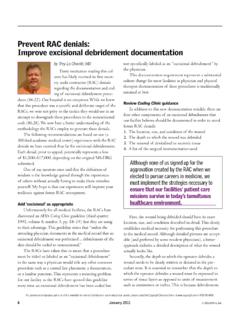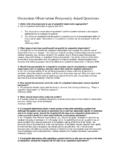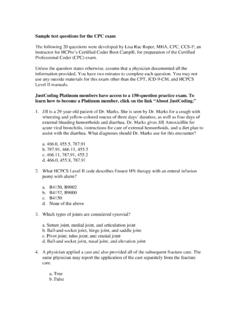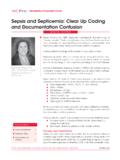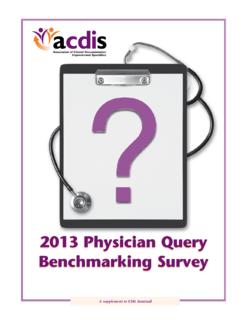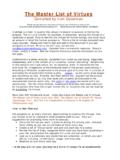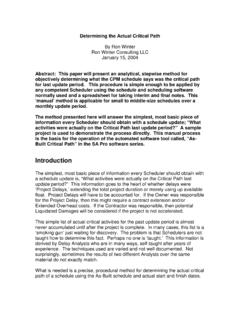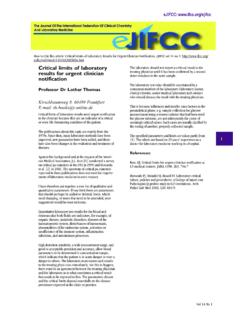Transcription of Ensure accurate reporting and coding of critical care
1 Ensure accurate reporting and coding of critical care When the AMA revised the instructions for report-ing ancillary services with critical care in 2011, facili-ties knew they wouldn t see an immediate increase in payment. CMS determines payment amounts through use of claims data from two years earlier, meaning the earliest facilities could expect additional reimbursement is , when CMS reviewed the 2011 claims data, it found no change in the costs/charges related to CPT codes 99291 ( critical care, evaluation and management of the critically ill or critically injured patient; first 30 74 minutes) and 99292 ( critical care, evaluation and management of the critically ill or critically injured patient; each additional 30 minutes). The claims also failed to show a significant increase in the ancillary services reported on these a result, CMS will not change its payment meth-odology for critical care services for 2013. CMS plans to continue its policy of packaging payment for ancillary services reported on the same date of service into CPT code 99291, noting that providing separate payment would actually result in overpayment.
2 Changes to critical care reportingCritical care is defined as the direct delivery of medical care by a physician or provider to a critically ill or injured patient. Typically, one or more vital organs or organ systems are impaired, and the patient s condition has a high probability of immediate deterio-ration. In addition, if critical services are not immediately rendered, the patient faces a high probability of CPT Editorial Panel revised its guidance for critical care codes 99291 and 99292 to specifically state that, for hospital reporting purposes, critical care codes do not include specified ancillary services. (For a list of these services, see p. 3.) Instead, the CPT guidelines instruct facilities to separately report ancillary services and associated charges provided in conjunction with critical care. CMS instructed hospitals to follow the CPT guidelines and report these services and associated charges change in the guidelines created significant problems for hospitals that previously trained coders to bundle ancillary services into the critical care code, says Caral Edelberg, CPC, CPMA, CAC, CCS-P, CHC, president of Edelberg Compliance Associates of Baton Rouge, 2012 Vol.
3 13, No. 10 IN THIS ISSUEp. 4 ICD-10 anatomy refresher: ShoulderAs part of our ongoing series of articles to help coders prepare for the transition to ICD-10-CM, we examine the anatomy of the 7 Simplify chronic kidney disease outpatient codingRecognize the stages of chronic kidney disease to unravel coding 9 This month s coding Q&AOur coding experts answer your questions about coding for hysteroscopy prior to ablation, appending modifier -59 for MRI and MRA, charging for venipunctures, therapy caps under OPPS, reporting limits for Provenge, modifier -59 and infusion therapy, reporting TEE pre- and postoperatively, and coding for toxic metabolic change in the CPT guidelines created significant problems for hospitals that previously trained coders to bundle ancillary services into the critical care code, says Caral Edelberg, CPC, CPMA, CAC, CCS-P, 2 Briefings on APCs October 2012 2012 HCPro, Inc. For permission to reproduce part or all of this newsletter for external distribution or use in educational packets, contact the Copyright Clearance Center at or , CMS also noted in Transmittal 2141 that it would institute claims processing edits that would continue to package the payment for these services into the payment for the critical care visit (CPT 99291), says Denise Williams, RN, CPC-H, vice president of revenue integrity services at Health Revenue Assurance Associates, Inc.
4 , in Plantation, ancillary services are not provided in conjunction with critical care, CMS will separately reimburse for them, Edelberg says. Coders should append modifier -59 (distinct procedural service) to the codes for ancillary services provided during a sepa-rate episode of care. Payment for those services will not be conditionally packaged into the payment for critical care, Edelberg says. Before CPT revised the reporting guidelines, payers often bundled all ancillary services in with the critical care payment, even if the services were not related to critical care. Coders can append modifier -59 to unbundle those services so the facility receives appropriate payment for services not related to critical care, Edelberg says. reporting critical care critical care codes are time-based codes, so providers must document time not just for proper reporting , but also so the facility can bill for its part of the services. Coders may struggle when it comes to counting critical care time for the facility.
5 This is a big, big question because it s easier to look at the start and stop time for the entire episode of care for that critical patient, Edelberg says. However, CMS has a very different definition of critical care time, she says. Under the OPPS, the time spent by a physician and/or hospital staff engaged in active face-to-face critical care of a criti-cally ill or critically injured patient is what is counted. If the physician and hospital staff are simultaneously engaged in this care, the time involved can only be counted once. It s interesting that CMS, in talking about OPPS critical care, references time spent by the physician and the critical care staff, Edelberg says. So CMS is l ooking to count the time spent by all of the providers in the emergency department, but only once. As a result, if a physician and a nurse are both providing critical care during the same 30-minute time span, coders can only report a total of 30 minutes of critical care time, not 60 minutes (30 for the physician and 30 for the nurse).
6 Editorial Advisory Board Briefings on APCsDave Fee, MBAP roduct Marketing Manager, Outpatient Products3M Health Information Systems Murray, UtahFrank J. Freeze, LPN, CCS, CPC-HPrincipalThe Wellington Group Valley View, OhioCarole L. Gammarino, RHIT, CPURR ecruiting Management, HIM ServicesPrecyse Solutions King of Prussia, E. Garrison, CHCA, CHCAS, PCS, FCS, CPC, CPC-H, CCS-P, CHC, CPARE xecutive Vice President of Healthcare Consulting Services Med Law Advisors, Inc. Atlanta, Anderwood Hoy, JD, CPCD irector of Medicare and ComplianceHCPro, , R. Jepsky, RN, MHA, LNCCEO & PresidentJepsky Healthcare Associates Sammamish, M. Jones, RHIA, CCSL olita M. Jones Consulting Services Fort Washington, Shah, MPHP residentNimitt Consulting Washington, on APCs (ISSN: 1530-6607 [print]; 1937-7649 [online]) is published monthly by HCPro, Inc., 75 Sylvan St., Suite A-101, Danvers, MA 01923. Subscription rate: $249/year. Copyright 2012 HCPro, Inc.
7 All rights reserved. Printed in the USA. Except where specifically encouraged, no part of this publication may be reproduced, in any form or by any means, without prior written consent of HCPro, Inc., or the Copyright Clearance Center at 978-750-8400. For editorial comments or questions, call 781-639-1872 or fax 781-639-7857. For renewal or subscription information, call customer service at 800-650-6787, fax 800-639-8511, or email Visit our website at Occasionally, we make our subscriber list available to selected companies/vendors. If you do not wish to be on this list, please write to the marketing department at the address above. Opinions expressed are not necessarily those of BAPCs. Mention of products and services does not constitute endorsement. Advice given is general, and readers should consult professional counsel for specific legal, ethical, or clinical questions. Current Procedural Terminology (CPT) is copyright 2008 American Medical Association.
8 All rights reserved. CPT is a registered trademark of American Medical Association; no fee schedules, basic units, relative values, or related listings are included in CPT. The AMA assumes no liability for the data contained herein. Applicable FARS/DFARS restrictions apply to government Managing Editor: Michelle Leppert, CPC-A, it s been more than six months since you purchased or renewed your subscription to BAPCs, be sure to check your envelope for your renewal notice or call customer service at 800-650-6787. Renew your subscription early to lock in the current t miss your next issue!October 2012 Briefings on APCs Page 3 2012 HCPro, Inc. For permission to reproduce part or all of this newsletter for external distribution or use in educational packets, contact the Copyright Clearance Center at or consider a slightly different scenario: The nurse provides 15 minutes of critical care and leaves. The physician comes in and provides 15 minutes of critical care and leaves.
9 The nurse then returns to provide an additional 15 minutes of care. In this case, coders would add the times together and report 45 minutes of critical care because none of the care overlapped. On the physician coding side, coders don t just count face-to-face time when reporting critical care. For physician reporting , critical care time includes any time the physician spent attending or providing services (directly or indirectly) to the patient. So it s bedside time, it s unit time, it s any time the physician spends managing the patient or the patient s condition, Edelberg says. That includes reviewing diagnostic studies, interpreting tests, talking to the pa-tient s family, and giving orders to other providers. As a result, the time the facility can bill for critical care may differ significantly from the time the physician can bill for critical care, she adds. Facilities need to create a process to capture critical care time for each provider in order to accurately bill for critical care services.
10 The process should allow the facility to capture both incremental and continuous time as well as time for each individual provider. It should also offer a way to identify overlapping time when two or more providers are involved in critical care. It s going to be very important if you are audited to show that your time has been counted very, very accurately, Edelberg says. CMS only pays for critical care if at least 30 minutes of critical care services are provided and documented. If the facility does not provide at least 30 minutes of critical care, coders should report a level 4 or 5 ED visit, depending on the facility s E/M criteria. That s why it s so important for your [ED E/M] criteria to be acuity distributed, Edelberg says. If for some reason you don t meet the critical care time, all of the resources that are part of critical care fall to a level 5 [E/M], not a level 4. Separately reportable servicesWhen reporting critical care, CPT guidelines now instruct facilities to separately report services, including: Interpretation of cardiac output measurements (93561, 93562) Chest x-rays (71010, 71015, 71020) Blood draw for specimen (36415) Blood gases and information data stored in computers ( , ECGs, blood pressures, hematologic data) (99090) Gastric intubations (43752, 43753) Pulse oximetry (94760, 94761, 94762) Temporary transcutaneous pacing (92953) Ventilator management (94002 94004, 94660, 94662) Vascular access procedures (36000, 36410, 36415, 36591, 36600)More than one physician can provide critical care and be paid if the service meets the definition of critical care, is medically necessary, and is not duplicative, says Edelberg.
